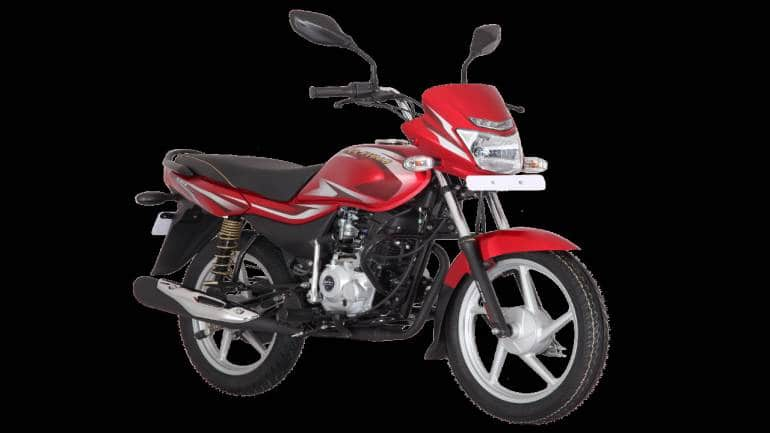Bajaj Auto: Exports under pressure, the Street says production cut ‘already factored in’, ‘rational’

Bajaj Platina is among the three models that the auto major exports.
Bajaj Auto’s exports have been under pressure for a few months now. Shipments fell 39 percent year-on-year in December 2022, 47 percent in January 2023 and 38 percent in February 2023.
The company’s exports for the three months were 132,931 units, 112,725 units and 126,935 units respectively. This dragged down total production volumes to around 280,000, which is nearly half the capacity Bajaj Auto has of approximately 550,000 units a month.
Also read: Bajaj Auto shares down most in five months on reports of production cut
What is going wrong?
It has to do with the two-wheeler maker’s export geographies.
Analysts estimate that around 50 percent of the company’s exports cater to African countries and in that a large part (30 percent of the total in FY20) caters to Nigeria. These markets have been experiencing massive disruptions recently, for political, macroeconomic and monetary reasons.
“Inflation, dollar unavailability and political changes have impacted the markets in these countries,” said Varun Baxi, research analyst (institutional), Antique Stock Broking.
Inflation in Nigeria touched 21.8 percent in January, far beyond the country’s monetary policy committee’s target range of 6-9 percent.
Food inflation, worsened by the Russia-Ukraine conflict, was 24.3 percent and core inflation, which excludes food and fuel, 19.2 percent. A dollar shortage is not new to the county but, in the current circumstances, it is being felt more acutely.
Local news reports suggest that businesses were sourcing most of their forex requirements through the black market.
Political, monetary turmoil
Politically, the country seems to be in turmoil. The ruling party has come back to power under Bola Tinubu amid complaints about electoral mismanagement. Politcal opponents are threatening to challenge the verdict.
“Elections in Nigeria have just concluded. It will take time for the government to form and settle in with policies,” said Jay Kale, Senior Vice President-Equity Analyst at Elara Capital. The brokerage has an “accumulate” call on Bajaj Auto.
Amid all of this, Nigeria’s central bank is overseeing a demonetisation exercise to take out old naira notes. News reports say that this exercise has brought businesses to a standstill and even caused riots.
TVS Motor, which also earns a good part of its export revenue from the Africa market, saw its export volumes fall significantly in February by 50 percent to 53,405 units. Its total volumes decreased 2 percent YoY to 276,150 units. But analysts said that the company’s exposure to that geography is much smaller than Bajaj Auto’s. They estimate it to be around 20-25 percent of its total exports, and its exposure to the Nigeria market to be half of that of Bajaj Auto’s.
Abhishek Gaoshinde, who is the Deputy Vice President of Research at Sharekhan by BNP Paribas, also pointed to two other key markets for the auto maker —Sri Lanka and Egypt.
“Sri Lanka is facing political and economic headwinds, and Egypt has banned import of three-wheelers,” he noted.
Also read: Profit-booking drags auto firms but analysts bullish on sector
Production cut?
Some newspaper reports said the company was planning a production cut, which senior management later denied through other newspaper reports. Analysts who Moneycontrol spoke to said the production cuts should come as no surprise; in fact it may become a business imperative.
“It might have made news but frankly we had already factored it in… If (export) volumes are half of the peak volumes, it is but natural that you have to cut production to save on costs,” said Elara Capital’s Kale.
He sees the export pressure continuing until May-June, in line with company management’s guidance in its December quarter earnings call.
According to industry experts, a large part of the earnings estimates would have been cut after the Q3FY23 earnings call. Now only incremental revisions will be made. Historically, an expert said that the company’s export margins are over 20 percent.
To Sharekhan’s Gaoshinde, “a lower rate of production is not a surprising but a rational outcome of the business activity.”
He said, “The production schedule aligns with the wholesale volume growth. BAL (Bajaj Auto Limited) has been facing headwinds in the export market for last six to seven months and hence production schedule has been following the wholesales volume growth trend.”
Domestic market
Can the capacity be diverted towards the domestic market? Highly unlikely, according to another industry analyst, who did not want to be named.
“Even though the capacities are fungible (that is, domestic and export capacities can be used for either) shifting capacities from domestic to export volumes and vice versa requires investment in time and money,” he said.
“Also, a large part of Bajaj Auto’s exports are in the 100-110 cc segments (with Boxer, Platina and Bajaj CT models) and this segment of the domestic market is not doing well (therefore the domestic market cannot absorb these additional capacities, if even diverted),” he added.
Elara Capital’s Kale said: “Domestic demand for two-wheelers itself is weak. The market is growing on a low base but it is way below the FY19 volume.”
Gaoshinde believes that the premiumisation trend in the domestic two-wheeler market will help Bajaj Auto even though it is an export-focussed company. Bajaj Auto has around 17 percent of the domestic market (9MFY23).
“The (domestic) two-wheeler industry is reporting a volatile performance largely because of delay in replacement buying,” he said, adding that a strong brand equity in the premium segment was supporting BAL.









